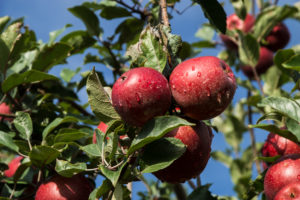WNC Orchard Insect Populations for September 11, 2018
go.ncsu.edu/readext?550631
en Español / em Português
El inglés es el idioma de control de esta página. En la medida en que haya algún conflicto entre la traducción al inglés y la traducción, el inglés prevalece.
Al hacer clic en el enlace de traducción se activa un servicio de traducción gratuito para convertir la página al español. Al igual que con cualquier traducción por Internet, la conversión no es sensible al contexto y puede que no traduzca el texto en su significado original. NC State Extension no garantiza la exactitud del texto traducido. Por favor, tenga en cuenta que algunas aplicaciones y/o servicios pueden no funcionar como se espera cuando se traducen.
Português
Inglês é o idioma de controle desta página. Na medida que haja algum conflito entre o texto original em Inglês e a tradução, o Inglês prevalece.
Ao clicar no link de tradução, um serviço gratuito de tradução será ativado para converter a página para o Português. Como em qualquer tradução pela internet, a conversão não é sensivel ao contexto e pode não ocorrer a tradução para o significado orginal. O serviço de Extensão da Carolina do Norte (NC State Extension) não garante a exatidão do texto traduzido. Por favor, observe que algumas funções ou serviços podem não funcionar como esperado após a tradução.
English
English is the controlling language of this page. To the extent there is any conflict between the English text and the translation, English controls.
Clicking on the translation link activates a free translation service to convert the page to Spanish. As with any Internet translation, the conversion is not context-sensitive and may not translate the text to its original meaning. NC State Extension does not guarantee the accuracy of the translated text. Please note that some applications and/or services may not function as expected when translated.
Collapse ▲September 11, 2018

As mid-September approaches, populations of most insect pests are on the decline. Codling moth, oriental fruit moth, and apple maggot are no longer of concern in >99% of orchards. While brown marmorated stink bug adults are still active, they too will soon begin to decline as they disperse to overwintering sites in the next 7 to 10 days. Overall, BMSB damage has been quite low, and averages less than 2% across more than 20 orchards sampled during the past week. The fact that overall damage did not appreciably increase since the last damage estimates in mid-August suggests that within-orchard populations are very low and the potential for further damage is also low. The expected rains associated with Hurricane Florence will further suppress BMSB activity.
Unless something unusual in the insect world occurs in the next couple of weeks, this will be the last Insect Update for 2018.
HOWEVER, if anyone comes across large numbers of BMSB adults congregating on homes, sheds, or vehicles in the coming weeks, or if you hear about large numbers of bugs occurring somewhere else, please get in contact with either Jim (828-684-3562) or Steve (828-713-4000). By large numbers, we’re talking about hundreds to thousands. We’re always looking for good collection sites, and willing to travel on short notice to collect.
Learn more about southeastern apple insect pests at the Apple Insect Management page.
2018 Average Weekly Trap Captures*
| HENDERSON COUNTY | |||
| Insects per trap | |||
| Aug 27 |
Sep 5 |
Sep 10 |
|
| Codling Moth | 0.0 | 0.8 | 0.0 |
| Oriental Fruit Moth | 29.0 | 40.0 | 15.0 |
| Tufted Apple Bud Moth | 0.0 | 0.0 | 0.0 |
| Redbanded Leafroller | 1.0 | 0.0 | 0.0 |
| Obliquebanded Leafroller | 1.0 | 0.0 | 0.0 |
| Lesser Appleworm | 0.0 | 0.0 | 1.0 |
| Apple Maggot (abandoned and research) | 4.0 | 1.0 | 0.5 |
| Brown Marmorated Stink Bug (commercial – mountains) | 2.2 | 4.2 | 2.2 |
| Brown Marmorated Stink Bug (commercial – upper piedmont) | 3.3 | 5.9 | 4.7 |
| Brown Marmorated Stink Bug (research – unsprayed) | 8.4 | 14.0 | 14.5 |
| Spotted Tentiform Leafminer | 0.0 | 0.0 | 0.0 |
| Dogwood Borer | 42.0 | 13.0 | 7.0 |
| Peachtree Borer | 27.0 | 28.5 | 4.5 |
| Lesser Peachtree Borer | 37.0 | 57.5 | 8.5 |
| San Jose Scale | 212.5 | 540.0 | 212.5 |
*Note that averages presented here are intended only to illustrate the timing of insect emergence and fluctuations in population activity, and not as general indicators of population levels. Some orchards included in these averages have significantly higher or lower populations than most commercial orchards in the area, resulting in averages that are sometimes skewed from what is typical. The only way to have an accurate assessment of an individual orchard’s populations is to set up traps in that orchard.
2018 Accumulated Degree Days
| Henderson County | ||||
| Biofix | Aug 28 |
Sep 6 |
Sep 11 |
|
| Codling Moth | Apr 30 | 2595 | 2844 | 2942 |
| Oriental Fruit Moth | Apr 2 | 3424 | 3723 | 3841 |
| Tufted Apple Bud Moth | May 4 | 3105 | 3404 | 3522 |
About degree-day models:The degree day (DD) models predict adult emergence and egg hatch of each generation. They do not predict the intensity of populations, which can be assessed by using pheromone traps. Hence, the models should be used to help gauge the time period when control is most likely needed, and pheromone traps provide information on the need for and frequency of insecticide applications. For full details, read “IPM Practices for Selected Pests” in the Orchard Management Guide. |
CODLING MOTH:
|
ORIENTAL FRUIT MOTH:
|
TUFTED APPLE BUD MOTH:
|


